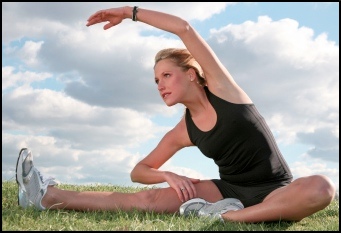Ballistic Stretches:
What They Are And How To Do Them
Ballistic stretches are a simple way to give your stretching routine some variation and build flexibility. But they also have some risks you should know about, so you don't hurt yourself.
Weight training is one of the best methods of strength training! If you want to start weight training safely and effectively, with the best info, diet, and routines, check out the 5 Day Beginner Weight Training Course!
So, What Is Stretching Ballistically?
Ballistic style stretches are stretches that use the momentum of the body (with relaxed or tense muscles) to extend your range of motion (ROM).[1] They typically involve bouncing or swinging a limb through its full range of movement.

They are different from static stretching, where you slowly ease into a position and hold it.
Bouncing down to touch your toes, or swinging your arms out, are both good examples. They are simple to do, and you can modify many common static stretches to be ballistic.
Does It Work? What Are The Advantages?
Yes, it works! Ballistics can increase your flexibility, especially dynamic flexibility (ROM when moving, esp. fast). This has been noted in karate practitioners, though it can help anyone interested in flexibility of movement.[2]
Plyometrics are a special kind or ballistic stretching that involves stretching the muscles, and then immediately contracting them in an explosive movement.[3] It's great for developing explosive power.
An especially effective method uses ballistics after regular, static stretching.[4] This works very well, and I really like it for building dynamic flexibility. It also helps if you're warmed up, like after a workout.
It has also been noted that, "ballistic is more controlled than most athletic activities. Therefore it [ballistic stretching] is likely to be much less dangerous than the sport itself if performed properly and not over aggressively."[5]
It's also a fun way to try something different in your stretching routine. Mix things up once in a while!
Concerns About Ballistics?
Many sources do not recommend ballistic stretching on the grounds that it is ineffective and can lead to injury.[6][7] And these are valid concerns!
The primary argument against ballistics is that if you stretch tissue too fast you can injure it. This is something to be aware of - but just don't be overly aggressive.
Also, fast stretching like this can induce the stretch reflex.[8] This is a protective reflex that tenses your muscles if they stretch too far too fast, in an effort to keep you from injury.
If the stretch reflex kicks in it can actually make you less flexible, as your muscles tense to protect yourself. Your ballistic stretching might actually make you tighter, unfortunately.
And finally, ballistically stretching quickly does not give time for the body to adapt to the increased ROM on a neuromuscular level.[9] Thus, your increased flexibility may not be as enduring as flexibility gained through longer, more relaxed periods of static stretching.
Should You Do Ballistics?
Unless you really need dynamic flexibility, for martial arts or gymnastics, you don't need ballistics. They are potentially dangerous and you really don't need the flexibility they'll give you.
But…
If you want to develop dynamic flexibility, and you have movements (like punches, kicks, or dance movements) that take you to the edge of your flexibility, then you might try ballistic style stretching. Add it at the end of your static stretching routine, make sure you're still warm, and start slowly.
Really, only go in for the ballistic stretching stuff if you have that specialized need for extreme dynamic flexibility - and you're already in pretty good shape!
Oh, and be sure to sign up for the e-zine Starting Strong to get monthly strength training, exercise, and diet tips e-mailed to you - and access to the free e-book Train Smart, Eat Smart: Exercise Nutrition Hacks!
• Click here to learn more about Exercise Stretches & Flexibility!
OR
References:
1. Alter, Michael J. 1996. Science of Flexibility. Champaign, IL: Human Kinetics.Pp. 157.
2. Ibid. Pp. 157-8.
3. Ibid. Pp. 158.
4. Ibid.
5. Ibid.
6. Appleton, Brad. 2001. Stretching and Flexibility: Everything You Never Wanted to Know. Roots & Wings. Pp. 17.
7. Deuster, Patricia A., Anita Singh, and Pierre A. Pelletier. 2007. The U.S. Navy SEAL Guide to Fitness and Nutrition. New York: Skyhorse Pub. Pp. 113.
8. Alter. Pp. 158.
9. Ibid.
Search CST...
|
Tweet Follow @Aaron_CST |
|
"About 2 weeks ago I read all the ab strengthening stuff on your site because I decided I wanted to be strong, instead of having a lot of belly fat. So I started eating healthier, running, exercising, you name it - everything your site said to do to help. Now I am noticing a real difference! Thank you for making this. :D xD" ~ Julia |
|
[This calorie calculator is] the most useful tool on the web that I can find… Also, I compared the calories calculated by your calculator to the calories calculated by the treadmill at my gym, and they're within a couple calories of each other, so yours is as accurate as we're going to get. REALLY AWESOME TOOL. I love it and depend on it. Thank you sooooo much for making this available." ~ Galit Sharon Marcus |
|
Thank you very much, I was too lean before 2 years (55 Kgs), after the gym now I'm 72kgs, all the muscles have developed... when someone hand shakes with me it can be squeezed easily, they're making fun of me! ~ Tamil Arasan |






New! Comments
Have your say about what you just read! Leave me a comment in the box below.